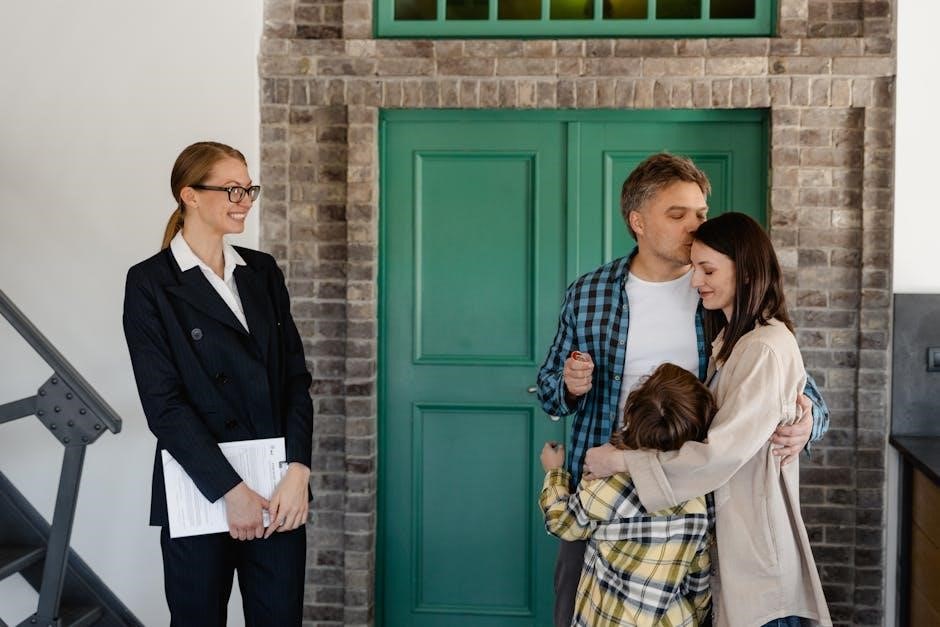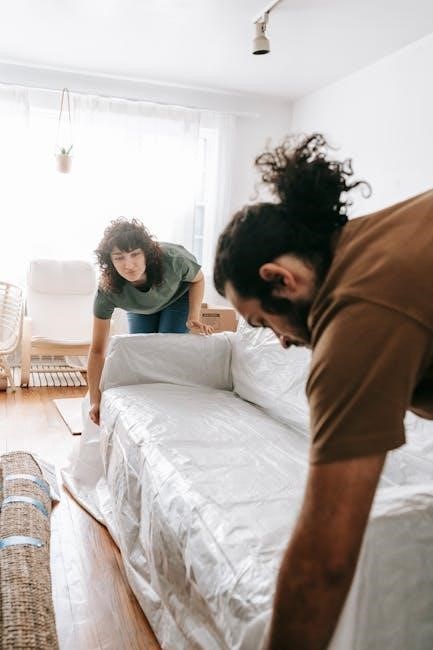
A 16x20x24 plyo box is a versatile, durable addition to home workouts, offering three heights in one design. Perfect for box jumps and HIIT training, it suits all fitness levels and can be built with a single sheet of plywood, making it a practical DIY project for home gym enthusiasts.
Overview of Plyo Boxes and Their Importance in Workouts
Plyo boxes are essential for enhancing explosive power and agility in fitness routines. They target key muscle groups, improving vertical jumps and overall athleticism. Used in HIIT, CrossFit, and strength training, plyo boxes offer a versatile workout tool. Their sturdy design supports intense exercises, making them a must-have for home gyms. DIY options like the 16x20x24 model provide affordability and customization, ensuring a perfect fit for any training style. These boxes are a cornerstone for functional training, helping athletes and fitness enthusiasts achieve their performance goals effectively.
Why Choose a 16x20x24 Plyo Box?
The 16x20x24 plyo box is an excellent choice for its triple-height versatility, accommodating various fitness levels. Its compact size is ideal for home gyms, while the durable construction withstands rigorous use. The design maximizes plywood efficiency, reducing waste and cost. With clear DIY plans available, users can customize their box to meet specific needs. This model is perfect for those seeking a space-saving, practical, and cost-effective solution to enhance their workout routine, offering flexibility for box jumps and other plyometric exercises. Its adaptability makes it a standout option for both beginners and advanced athletes.

Benefits of Building a DIY Plyo Box
Building a DIY plyo box saves money and offers customization. It enhances home workouts with a durable, versatile tool, perfect for box jumps and HIIT training.
Cost-Effectiveness Compared to Commercial Options
Building a DIY plyo box is a cost-effective alternative to commercial options, offering significant savings; A single sheet of plywood can be used to construct a durable 16x20x24 box, reducing material waste and costs. Commercial plyo boxes often come with hefty price tags, while DIY plans allow you to create a high-quality box at a fraction of the cost. This makes it an ideal choice for fitness enthusiasts on a budget; The affordability and simplicity of DIY construction ensure you can enjoy professional-grade equipment without financial strain, making it a practical investment for home workouts.
Customization Options for Height and Design
The 16x20x24 plyo box plans offer exceptional versatility, allowing users to customize the height to suit their fitness level. With three distinct heights (16″, 20″, and 24″), the box caters to both beginners and advanced athletes. DIY enthusiasts can also tailor the design to their preferences, such as adding a non-slip surface or personalizing the finish with paint or decals. This flexibility ensures the box meets individual needs while maintaining durability and functionality. The ability to adjust and customize makes it a standout option for those seeking a personalized workout experience without compromising on quality or performance.

Materials and Tools Needed
Essential materials include 1/2″ or 3/4″ plywood for durability, 2″ wood screws, wood glue, and sandpaper. Tools required are a circular saw, drill, measuring tape, clamps, and jigsaw for precise cuts. Safety gear like gloves and safety glasses is also recommended to ensure a safe assembly process.
Wood Selection: Types of Plywood for Durability
For a 16x20x24 plyo box, 1/2″ or 3/4″ plywood is ideal, offering durability and stability. Choose high-quality, void-free plywood like birch or oak for strength. Marine plywood is another excellent option for moisture resistance. Ensure the plywood is free from defects and warping to maintain structural integrity. Sanding the wood before assembly ensures a smooth finish and prevents splinters. Proper wood selection is crucial for a long-lasting, professional-grade plyo box that can withstand repetitive use and heavy impacts during workouts.
Hardware Requirements: Screws, Glue, and Fasteners

Essential hardware for a 16x20x24 plyo box includes 2-inch wood screws for securing joints and 1.5-inch screws for additional reinforcement. Wood glue is critical for bonding surfaces, ensuring long-term durability. Use high-quality fasteners to prevent loosening over time. Proper hardware selection ensures structural integrity and safety, especially under heavy use. Avoid using nails, as they may not provide the same stability. Always pre-drill holes to avoid splitting the wood, and apply glue liberally for a strong bond. Investing in durable hardware guarantees a sturdy, professional-grade plyo box capable of withstanding rigorous workouts.
Tools: Essential Equipment for Assembly
To assemble a 16x20x24 plyo box, you’ll need a power drill for pre-drilling holes and driving screws. An impact driver is ideal for securing screws quickly. A measuring tape ensures precise cuts and alignments. Clamps are crucial for holding pieces in place during assembly. A square helps maintain accurate angles, while a utility knife or circular saw is necessary for cutting plywood. Sandpaper smooths rough edges, and a pencil marks cut lines. Safety glasses and gloves are essential for protection. Optional tools include a rubber mallet for tapping pieces into place and a jigsaw for intricate cuts. Proper tools ensure a professional finish and safe assembly.

Step-by-Step Assembly Guide
Begin by cutting the plywood according to the specified dimensions. Assemble the sides and attach the bottom using screws and wood glue for stability. Sand all edges for a smooth finish before final assembly to ensure durability and safety during use.
Pre-Drilling Pilot Holes for Stability
Pre-drilling pilot holes is a critical step to ensure the structural integrity of your plyo box. Start by marking the locations for screws on each piece of wood. Use a drill bit slightly smaller than the screws to create pilot holes, preventing the wood from splitting. This step is especially important at the corners and along the edges where stress concentrations occur. After drilling, apply wood glue to the edges and secure the pieces together using 2-inch wood screws. Proper alignment and tight fitting are essential to maintain stability and durability for heavy use during workouts. Patience and precision here will pay off in the long run.
Attaching Sides and Bottom for Structural Integrity
Attach the sides and bottom of the plyo box securely to ensure long-lasting stability. Begin by aligning the sides with the bottom piece, ensuring proper fitment. Use 2-inch wood screws to fasten the sides to the bottom, starting from the corners and working your way outward. Apply even pressure to prevent warping. Use clamps to hold the pieces in place while screwing. Double-check alignment and ensure all sides are flush. Once the sides are attached, inspect the joints for any gaps or misalignments. A sturdy base is crucial for withstanding repetitive impact during workouts, so take your time to ensure a tight, even fit.
Final Assembly and Reinforcement Techniques
Final assembly involves securely attaching all components to ensure maximum durability. Apply wood glue to the joints and use 2-inch screws to reinforce the structure. For added strength, consider adding metal brackets to the corners. Sand all edges to prevent splinters. Allow the glue to dry completely before use. This step ensures the box can handle heavy use and repeated impacts during workouts; Proper reinforcement is crucial for safety and longevity.

Safety Tips for Using a DIY Plyo Box
Ensure the box is placed on a stable, flat surface. Always inspect for damage before use. Start with lower heights and gradually increase intensity. Avoid overloading beyond weight limits to prevent accidents and ensure a safe workout experience.
Proper Handling and Placement
Always place the plyo box on a stable, flat surface to ensure balance. Inspect the box for any damage or wear before use. Position it in an open area, away from walls or obstacles, to allow safe movement. When performing box jumps, step onto the box with control and descend carefully to avoid injury. Ensure the box is securely positioned to prevent shifting during use. Proper handling and placement are crucial for maximizing safety and effectiveness in your workouts.
Weight Limits and Usage Guidelines
Your DIY 16x20x24 plyo box should support a maximum weight of 250-300 pounds, depending on construction quality. Always ensure the box is stable before use. Start with lower heights and gradually increase difficulty. Avoid reckless jumps or excessive force, as this may damage the box or cause injury. Clean the surface regularly to prevent slipping. Follow proper jumping techniques to maximize safety and effectiveness. Regularly inspect the box for wear or damage, and make repairs promptly to maintain durability and performance during workouts.

PDF Plans and Resources

Download comprehensive 16x20x24 plyo box PDF plans featuring detailed step-by-step instructions, material lists, and cutting layouts. These guides ensure accurate construction for a durable and safe design.
Where to Find Reliable 16x20x24 Plyo Box Plans
Reliable 16x20x24 plyo box plans can be found on trusted DIY and fitness websites. Sites like health-bent.com offer comprehensive PDF guides with step-by-step instructions and material lists. Additionally, fitness enthusiasts often share plans on forums and DIY communities. Ensure the plans include clear cutting layouts and assembly details for accuracy. Look for resources that highlight durability and safety features, such as pre-drilling pilot holes and using wood glue. Verified sources like Rogue Fitness-inspired designs are also excellent starting points for a sturdy and functional plyo box.
Key Features of a Comprehensive PDF Guide
A thorough 16x20x24 plyo box PDF guide includes detailed step-by-step instructions, material cut-lists, and cutting layouts. Look for plans with clear photos and diagrams to simplify assembly. Many guides, like the 7-page document from 2018, offer exploded views and assembly sequences. Ensure the guide includes safety tips, weight limits, and customization options. A good PDF should also cover pre-drilling techniques and hardware recommendations for durability. Some guides even provide multiple height options, making it versatile for different workout needs. Always verify the guide’s completeness to ensure a successful DIY project.

Common Mistakes to Avoid
Measurement errors and improper assembly are common pitfalls. Ensure accurate cuts and secure joints to maintain durability and safety. Avoid rushing the pre-drilling process for stability.
Measurement Errors and Their Impact
Measurement errors can lead to a poorly constructed plyo box, compromising its stability and safety. Even slight miscalculations in cutting wood or drilling holes can result in uneven surfaces or a weakened structure. This can cause the box to wobble during use, increasing the risk of injury. To avoid this, use a tape measure and square to ensure precise cuts and alignments. Double-check all dimensions before cutting to maintain the integrity of the design. Accurate measurements are crucial for a durable and safe DIY plyo box that withstands rigorous workouts.
Assembly Mistakes That Compromise Durability
Common assembly errors, such as failing to pre-drill pilot holes or using incorrect screw sizes, can weaken the plyo box’s structure. Misaligning the sides or bottom panel can lead to instability and uneven surfaces. Over-tightening screws may split the wood, while under-tightening can result in a wobbly box. Additionally, skipping the use of wood glue or not allowing it to dry properly can compromise the joints’ strength. Rushing the assembly without ensuring all pieces fit snugly can lead to a box that cannot withstand repeated impact during workouts.
Building a 16x20x24 plyo box is a cost-effective and rewarding DIY project, offering customization and durability for home workouts. Start your project today and enjoy the benefits of a sturdy, versatile training tool!
Final Thoughts on Building a 16x20x24 Plyo Box
Constructing a 16x20x24 plyo box is a rewarding DIY project that enhances home workouts with a versatile, sturdy tool. With plans readily available online, including detailed PDF guides, you can customize the design to suit your fitness needs. The process is cost-effective and allows for personalization, ensuring durability and functionality. By following step-by-step instructions and using quality materials, you can create a professional-grade plyo box that stands the test of intense training sessions. Embrace the satisfaction of building your own equipment and elevate your fitness journey with this essential addition to your home gym.
Encouragement to Start Your DIY Project
Embark on your DIY journey with confidence! Building a 16x20x24 plyo box is a fun and rewarding project that enhances your home workouts. With detailed PDF plans available, you’ll have clear guidance to ensure success. This cost-effective solution allows you to customize your equipment to your fitness needs, saving money and gaining a sense of accomplishment. Take the leap, gather your tools, and start creating a durable, professional-grade plyo box that will elevate your training. DIY projects empower you to take control of your fitness journey, making it both enjoyable and fulfilling.